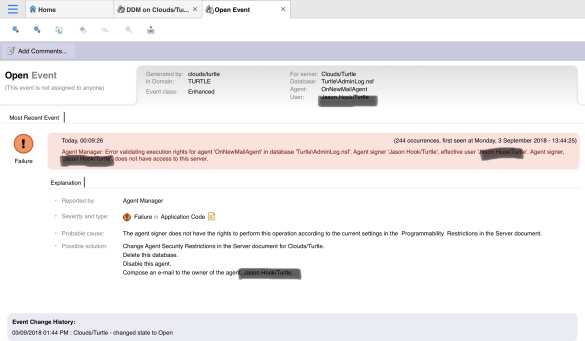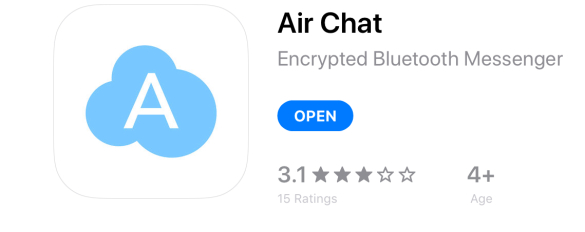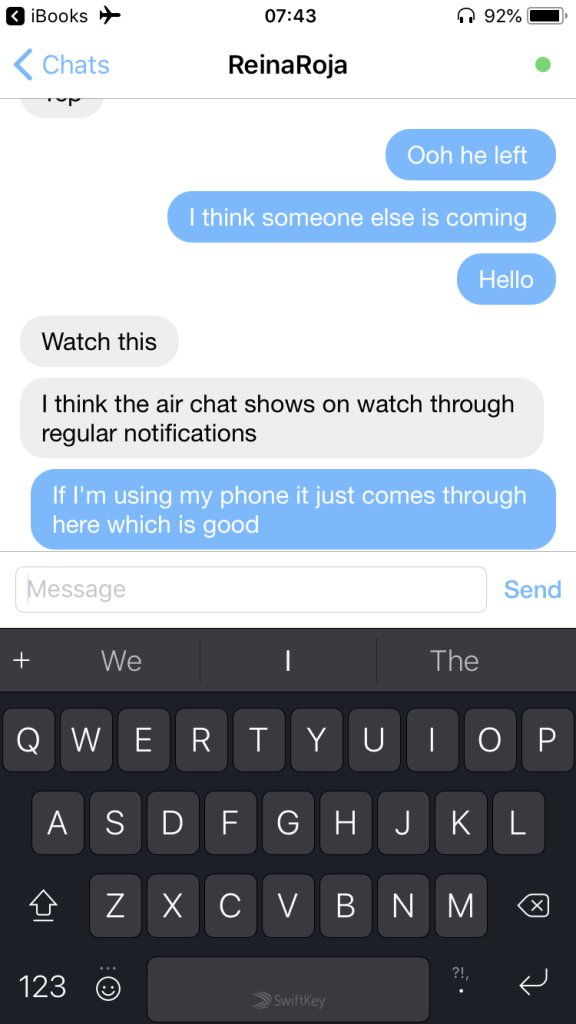This week I spent time in Milan at HCL’s 2nd factory tour at their offices. It was an intense couple of days, with presentations from the development teams working on Domino, Notes, Nomad, Sametime, DQL, etc, as well as HCL executives working on building the support program, the partner program, and HCL’s client advocacy program.
After several great discussions with people from HCL and IBM all I can say is that things are moving F-A-S-T and thank you in particular to Richard Jefts, Russ Holden, John Curtis, Tony Blake, Pat Galvin and Francois Nasser for listening to my ideas even if they end up being unworkable.
Note there was no discussion of Connections at all as that deal with IBM is not finalised and HCL aren’t in a position to discuss it. HCL are targeting April 1st for the deal and early June for everything to be transitioned over, with the v11 beta this summer and the v11 launch around end of Q4.
Here are some highlights that I noted from the conversations and sessions that I want to share here. I apologise if I have incorrectly noted what I heard.
Domino (presented by Russ Holden) - v11 Features
- Directory Sync from Active Directory to Domino Directory. Renames made in AD will trigger a Domino rename. Attempting to get rid of or at least minimise the HTTP password field and make AD authoritative. We had discussions about whether attributes in AD should/could be written to by Domino or if AD was to be the single authoritative and management source.
- HTTP password authentication via ID Vault instead of person document, including the ability to keep the Notes password and HTTP password in the vault in sync.*Those of us who work with Traveler know the risk of changing the HTTP password until we get client certificate authentication in Traveler, and we shared that with Russ as well.
- DAOS will still exist but in v11 there will also be Cloud Object Storage where a single instance of an attachment per note ID will be stored in Amazon’s S3 cloud by default but with the option for extensions to other servers.The concept is that it would potentially save on both on premises storage costs and backup requirements for the attachment store. It’s not intended to be a space saving offering over DAOS as although there will be one instance of an attachment regardless of cluster replicas, that instance is based on the note id of the document. That means whereas with DAOS an email sent to 40 people will generate only a single NLO on each cluster server, with this model there would be 40 attachments all accessible by any server in the cluster. How appropriate this will be as a solution will be dependent on your storage and backup requirements as well as your typical mail usage.
- A new PubSub feature that will allow applications to subscribe for updates that Domino will publish rather than poll for them. Traveler is a good example, currently Traveler scans each user’s mail file on a polled interval to see if there are updates and if there are it then grabs them to send to your device. Polling databases asking for “anything new to tell me” is a lot of unnecessary overhead when the alternative is Domino publishing updates each time there is activity (note adds, deletes, folder adds etc). The ability to subscribe to specific databases you want immediate activity on and for Domino to publish that activity to you as it happens obviously has a huge scope beyond performance outside of Domino as well.Which leads us to…
- Using ElasticSearch for searching which will utilise the PubSub functionality in order to get immediate updates to process. ElasticSearch will be configurable on a database-by-database basis including the option to have it take the place of Domino FT search. One of my issues with ElasticSearch is its security model and they are also working on an API to address that so that we get security parity with the current FT search model.
- Message recall for undelivered (scheduled or queued) mail.
The Clients (presented by Andrew Davis, Maxx Sutton, Barry Rosen)
The focus for v11 is very much around the client delivery and UI.
There is a new UI under development for Notes and some of its key templates that modernises it and brings it more in line with the UI design of Verse. These are early stages but they will be part of the v11 ship. Verse continues to be extended with very welcome upcoming support for mobile browsers and a goal to have parity with iNotes by the end of this year.
HCL Nomad, currently on public beta for iPad (yes, they know we want it SHIPPED) was demoed for Android and ChromeOS at Think and to us this week. iPhone is also on the way. To develop for Android HCL used OpenGL and that code can also be compiled as WebGL which, using WebAssembly, will enable Nomad to run in most browsers with the same fidelity and behaviour as on the mobile devices.
I’m not saying that would give us a lightweight client but it would totally give us a lightweight client that could be used in something like HCL Places for instance.
Sametime (presented by Pat Galvin)
Sametime 10 Limited Use, that now includes mobile entitlement, is on track to be delivered in the first half of this year. The persistent chat feature that allows chats to be routed to multiple devices you are logged into will, in the first instance, require MongoDB with Domino coming “later”. I have a big problem with this. Neither me nor my customers want to bring the overhead of MongoDB into a Domino site just for this single feature regardless of how welcome that feature is. I hope HCL prioritise “later” as “soonest” to be honest otherwise I suspect we’ll be deploying v10 of Sametime initially without its biggest feature.
Platforms will be Windows initially then Linux. All 64bit.
Sametime will be released lock step with Domino, so at the end of this year Domino 11 will support the product released as Sametime 11. Targeted for release with v11 is Docker deployment and support for integration with Zoom, Webex, etc. Stretch goals for v11 include getting rid of the Sametime System Console and the ability to invite external guests into chats.
In addition, they are looking to deliver chat enhancements in v11 such as read status on messages, @mentions, and multi-device file transfer so you can select which device a received file is downloaded to as well as choosing which device to answer an audio / video call on if you are logged into multiple devices.
Finally for meetings I’m delighted to hear that they are working to remove the accursed browser plugins for audio and video from v11.
Sametime 12+ includes targets that are stretch goals on v11 and additional targets such as removing WebSphere and DB2.
DQL (Presented by John Curtis)
The 1.0.1 Appdev pack which contains all the functionality you need to deploy DQL from Node is out this quarter. The plan is to have quarterly updates to the Appdev pack introducing new features. Some things planned for future updates include:
OAuth authentication. This is a huge deal and has to be done right. DQL only works as a solution if we can maintain the same security model that Domino gives us and OAuth has the ability to give us that. Currently the OAuth implementation in the Appdev pack is application level, meaning one identity shared by anyone using that application which means no reader fields of custom user security.
They are working to support on-the-fly computation of formulas to support things like computed for display fields.
For searching there will be support for both FT Search and the new ElasticSearch with indexes created across databases and in attachments where required. Searching rich text and mime is also on the agenda.
These are just some of my highlights. There was a lot more and if you want to get involved I highly recommend registering for Engage UG in Brussels this May (14/15) https://engage.ug. It’s a free user group event and HCL will be there in force with a lot more to show, hopefully on the heels of some beta content.
If you want to add your own enhancement requests and suggestions definitely to go the aha! site and add them there. Everyone who spoke said they monitored that site and many of the features that are coming are based on posts there.
https://domino.ideas.aha.io/
HCL Client Advocacy - (presented by John Immerman)
If you are a customer or a business partner please sign up for the Client Advocacy Program @ HCL. John Paganetti and his team will connect you with a developer advocate who will work with you to make sure your requests are heard, your PMRs don’t stall, and your ideas are taken seriously. Much of what they do is learning about how you use the tools and what your pain points and wishes are. This speaks to the core of who HCL are and I can’t think of any other company who would commit skilled expert resources to these kind of relationships. If you want to be heard go register here. There are 200 companies registered already with hundreds more requested and being personally contacted. Nothing about this is automated so don’t pass up the opportunity.
https://www.cwpcollaboration.com
Support - (presented by Michael Fiorentino)
The support model is still transitioning over from IBM including hundreds of thousands of technotes and HCL are moving away from the Salesforce support interface that IBM use to a simpler more streamlined one. The big question I wanted to ask was whether HCL would do away with the login requirement to read technotes or get patches. Currently IBM require you to be a customer with a support license to be able to read technotes and find out what may be wrong. I’ve always thought that’s crazy and I know it frustrates customers and partners alike. Both Richard Jefts and Michael Fiorentino confirmed that is not how they plan to run things and that’s a great start.
Michael also wanted to understand the business partner requirements so he could structure things to make it easier for us to open calls at the right level of expertise and to do so on behalf of our customers in an easier way. Michael has a frankly astonishing amount of work ahead of him to get the support structure right, but he was very open to all our ideas and comments and I honestly believe they are committed to doing this right and not “business as usual”.
I heard from more people there of really good IBM’ers who are moving to HCL. I don’t want to name them here as that’s their business but I’m delighted they are joining.
Let’s all work together and do great things.




